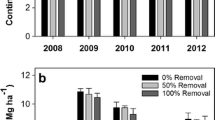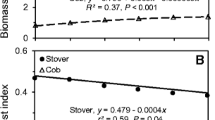Abstract
Corn (Zea mays L.) stover was identified as an important feedstock for cellulosic bioenergy production because of the extensive area upon which the crop is already grown. This report summarizes 239 site-years of field research examining effects of zero, moderate, and high stover removal rates at 36 sites in seven different states. Grain and stover yields from all sites as well as N, P, and K removal from 28 sites are summarized for nine longitude and six latitude bands, two tillage practices (conventional vs no tillage), two stover-harvest methods (machine vs calculated), and two crop rotations {continuous corn (maize) vs corn/soybean [Glycine max (L.) Merr.]}. Mean grain yields ranged from 5.0 to 12.0 Mg ha−1 (80 to 192 bu ac−1). Harvesting an average of 3.9 or 7.2 Mg ha−1 (1.7 or 3.2 tons ac−1) of the corn stover resulted in a slight increase in grain yield at 57 and 51 % of the sites, respectively. Average no-till grain yields were significantly lower than with conventional tillage when stover was not harvested, but not when it was collected. Plant samples collected between physiological maturity and combine harvest showed that compared to not harvesting stover, N, P, and K removal was increased by 24, 2.7, and 31 kg ha−1, respectively, with moderate (3.9 Mg ha−1) harvest and by 47, 5.5, and 62 kg ha−1, respectively, with high (7.2 Mg ha−1) removal. This data will be useful for verifying simulation models and available corn stover feedstock projections, but is too variable for planning site-specific stover harvest.

Similar content being viewed by others
Notes
Mention of a trademark or proprietary product is for information only and does not represent an endorsement by the USDA Agricultural Research Service, Department of Energy, or any university partner associated with this project.
References
Keeler BL, Krohn BJ, Nickerson TA, Hill JD (2013) U.S. federal agency models offer different visions for achieving renewable fuel standard (RFS2) biofuel volumes. Environ Sci Technol 47:10095–10101
Perlack RD, Wright LL, Turhollow AF, Graham RL, Stokes BJ, Erbach DC (2005) Biomass as feedstock for a bioenergy and bioproducts industry: the technical feasibility of a billion-ton annual supply. DOE/GO-102005-2135 and ORNL/TM-2005/66. http://feedstockreview.ornl.gov/pdf/billion_ton_vision.pdf. Accessed 7 Jan 2014
USDA-National Agricultural Statistics Service (NASS) (2013) Data and Statistics [online]. Washington DC, USA. http://www.nass.usda.gov/Data_and_Statistics/Quick_Stats/index.asp. Accessed 7 Jan 2014
Schroeder J (2011) Finding fuel in agricultural waste. Domestic Fuel. http://domesticfuel.com/2011/01/27/finding-fuel-in-agricultural-waste/. Accessed 7 Jan 2014
U.S. Department of Energy (2011) U.S. billion-ton update: biomass supply for a bioenergy and bioproducts industry. Perlack RD, Stokes BJ (leads), ORNL/TM-2011/224. Oak Ridge National Laboratory, Oak Ridge, TN. 227 pp
Lavigne A, Powers SE (2007) Evaluating fuel ethanol feedstocks from energy policy perspectives: a comparative energy assessment of corn and corn stover. Energy Pol 35:5918–5930
Searchinger T, Heimlich R, Houghton RA, Dong F, Elobeid A, Fabiosa J, Tokgoz S, Hayes D, Yu T (2008) Use of U.S. croplands for biofuels increases greenhouse gases through emissions from land use change. Science 319:1238–1240
Moore KJ, Karlen DL, Lamkey KR (2013) Future prospects for corn as a biofuel crop. In: Goldman SL, Kole C (eds) Compendium of bioenergy plants: corn. CRC Press, Boca Raton, pp 331–352
Biomass Research and Development Board (BRDB) (2008) Increasing feedstock production for biofuels: economic drivers, environmental implications and the role of research. http://www.ascension-publishing.com/BIZ/HD4-Brdi.pdf. Accessed 7 Jan 2014
Nelson RG (2002) Resource assessment and removal analysis for corn stover and wheat straw in the Eastern and Midwestern United States—rainfall and wind-induced soil erosion methodology. Biomass Bioenergy 22:349–363
Duffy MD (2014) Estimated costs of crop production in Iowa—2014. FM-1712 (revised January 2014) Iowa State University Extension and Outreach, Ames, IA. https://store.extension.iastate.edu/ItemDetail.aspx?ProductID=1793. Accessed 7 Jan 2014
Johnson JMF, Papiernik SK, Mikha MM, Spokas KA, Tomer MD, Weyers SL (2010) Soil processes and residue harvest management. In: Lal R, Stewart BA (eds) Carbon management, fuels, and soil quality. Taylor & Francis, New York, pp 1–44
Wilhelm WW, Hess JR, Karlen DL, Johnson JMF, Muth DJ, Baker JM, Gollany HT, Novak JM, Stott DE, Varvel GE (2010) Review: balancing limiting factors and economic drivers for sustainable Midwestern US agricultural residue feedstock supplies. Ind Biotechnol 6:271–287
Wilhelm WW, Johnson JMF, Karlen DL, Lightle DT (2007) Corn stover to sustain soil organic carbon further constrains biomass supply. Agron J 99:1665–1667
Karlen DL, Birrell SJ, Hess JR (2011) A five-year assessment of corn stover harvest in Central Iowa, USA. Soil Tillage Res 115–116:47–55
Karlen DL, Varvel GE, Johnson JMF, Baker JM, Osborne SL, Novak JM, Adler PR, Roth GW, Birrell SJ (2011) Monitoring soil quality to assess the sustainability of harvesting corn stover. Agron J 103:288–295
Karlen DL, Birrell SJ, Wirt AR (2012). Corn stover harvest strategy effects on grain yield and soil quality indicators. In: Ernst O, Pérez M, Terra J, Barbazán M (eds) Striving for sustainable high productivity through improved soil and crop management. Proc. of the 19th Triennial ISTRO conference, Montevideo, Uruguay. Special Issue: Agrociencia Uruguay. ISSN 1510–0839
Blanco-Canqui H, Lal R (2009) Crop residue removal impacts on soil productivity and environmental quality. Crit Rev Plant Sci 28:139–163
Karlen DL, Hunt PG, Campbell RB (1984) Crop residue removal effects on corn yield and fertility of a Norfolk sandy loam. Soil Sci Soc Am J 48:868–872
Karlen DL (2004) Cropping systems: rain-fed maize-soybean rotations of North America. In: Goodman RM (ed) Encyclopedia of plant and crop science. Marcel Dekker, New York, pp 358–362
Muth DJ Jr, McCorkle DS, Koch JB, Bryden KM (2012) Modeling sustainable agricultural residue removal on the subfield scale. Agron J 104:970–981
Hoskinson RL, Karlen DL, Birrell SJ, Radtke CW, Wilhelm WW (2007) Engineering, nutrient removal and feedstock conversion evaluations of four corn stover harvest scenarios. Biomass Bioenergy 31:126–136
Karlen DL (2010) Corn stover feedstock trials to support predictive modeling. Glob Chang Biol - Bioenergy 2:235–247
Del Grosso SJ, White JW, Wilson G, Vandenberg B, Karlen DL, Follett RF, Johnson JMF, Franzluebbers AJ, Archer DW, Gollany HT, Liebig MA, Ascough J, Reyes-Fox M, Pellack L, Starr J, Barbour N, Polumsky RW, Gutwein M, James D (2013) Introducing the GRACEnet/REAP data contribution, discovery, and retrieval system. J Environ Qual 42:1274–1280
Acknowledgement
The U.S. Department of Agriculture offers its programs to all eligible persons regardless of race, color, age, sex, or national origin and is an equal-opportunity employer. This research was funded by the USDA-Agricultural Research Service as part of the USDA-ARS Resilient Economic Agricultural Practices (REAP) project with additional funds from the North Central Regional Sun Grant Center at South Dakota State University through a grant provided by the U.S. Department of Energy (DOE)—Office of Biomass Programs [now known as the Bioenergy Technology Office (BETO)] under award number DE-FC36-05GO85041.
Author information
Authors and Affiliations
Corresponding author
Appendix
Appendix
Rights and permissions
About this article
Cite this article
Karlen, D.L., Birrell, S.J., Johnson, J.M.F. et al. Multilocation Corn Stover Harvest Effects on Crop Yields and Nutrient Removal. Bioenerg. Res. 7, 528–539 (2014). https://doi.org/10.1007/s12155-014-9419-7
Published:
Issue Date:
DOI: https://doi.org/10.1007/s12155-014-9419-7




